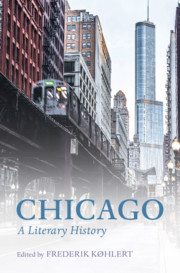Book contents
- Chicago: A Literary History
- Chicago
- Copyright page
- Contents
- Figures
- Contributors
- Acknowledgments
- Introduction: The Literary History of Chicago
- Part I The Rise of Chicago and the Literary West
- Part II Business Unusual: A New Urban American Literature
- Part III Radicalism, Modernism, and the Chicago Renaissance
- Part IV A City of Neighborhoods: The Great Depression, Sociology, and the Black Chicago Renaissance
- Chapter 17 Chicago Ecology and James T. Farrell’s Studs Lonigan
- Chapter 18 Chicago Gets the Blues: Migration, Depression, and the Black Renaissance
- Chapter 19 Black Chicago: Richard Wright’s South Side
- Chapter 20 Life in Bronzeville: Humanism and Community in the Work of Gwendolyn Brooks
- Chapter 21 Hustlers, Junkies, and Prostitutes: Nelson Algren’s White Slums
- Chapter 22 From Emptyland to Uncanny City: Saul Bellow’s Jewish Chicago
- Part V Traditions and Futures: Contemporary Chicago Literatures
- Selected Bibliography
- Index
Chapter 18 - Chicago Gets the Blues: Migration, Depression, and the Black Renaissance
from Part IV - A City of Neighborhoods: The Great Depression, Sociology, and the Black Chicago Renaissance
Published online by Cambridge University Press: 02 September 2021
- Chicago: A Literary History
- Chicago
- Copyright page
- Contents
- Figures
- Contributors
- Acknowledgments
- Introduction: The Literary History of Chicago
- Part I The Rise of Chicago and the Literary West
- Part II Business Unusual: A New Urban American Literature
- Part III Radicalism, Modernism, and the Chicago Renaissance
- Part IV A City of Neighborhoods: The Great Depression, Sociology, and the Black Chicago Renaissance
- Chapter 17 Chicago Ecology and James T. Farrell’s Studs Lonigan
- Chapter 18 Chicago Gets the Blues: Migration, Depression, and the Black Renaissance
- Chapter 19 Black Chicago: Richard Wright’s South Side
- Chapter 20 Life in Bronzeville: Humanism and Community in the Work of Gwendolyn Brooks
- Chapter 21 Hustlers, Junkies, and Prostitutes: Nelson Algren’s White Slums
- Chapter 22 From Emptyland to Uncanny City: Saul Bellow’s Jewish Chicago
- Part V Traditions and Futures: Contemporary Chicago Literatures
- Selected Bibliography
- Index
Summary
From the Great Depression to the early 1950s, Chicago was the center of African American literary production. On the South Side, writers such as Richard Wright, Gwendolyn Brooks, Frank Marshall Davis, Margaret Walker, and William Attaway authored works that broke new ground in African American letters. They came of age artistically in the wake of the Great Migration, and the migratory experience and the challenges of creating new lives in the city became the grand themes of their writing and underpinned a broader creative flowering first manifested in the vibrant jazz and blues of the 1920s. Through local institutions, New Deal cultural agencies, and left-wing artists’ organizations, writers of the Black Chicago Renaissance interacted with performing and visual artists and social scientists, achieved unprecedented critical and commercial success, and sought to build infrastructures supporting black cultural initiatives. Collectively, they created a body of literature that was thematically powerful enough to portray a time of massive economic desperation and social dislocation while stylistically supple enough to incorporate many of the formal innovations of literary modernism.
Keywords
- Type
- Chapter
- Information
- ChicagoA Literary History, pp. 253 - 268Publisher: Cambridge University PressPrint publication year: 2021

